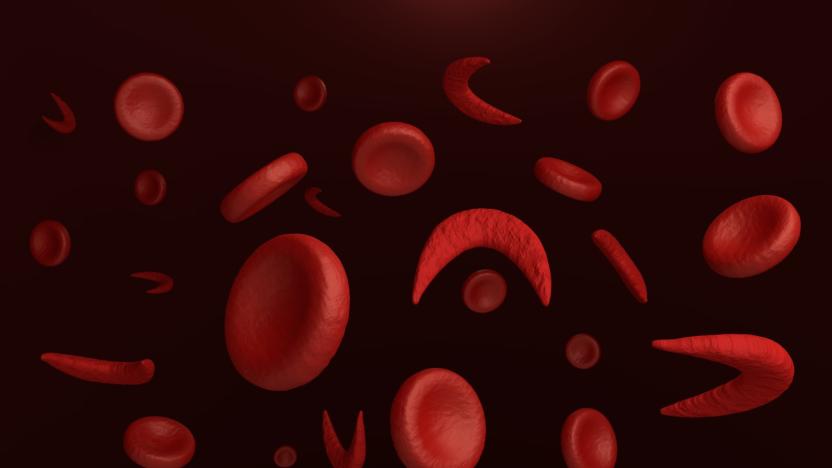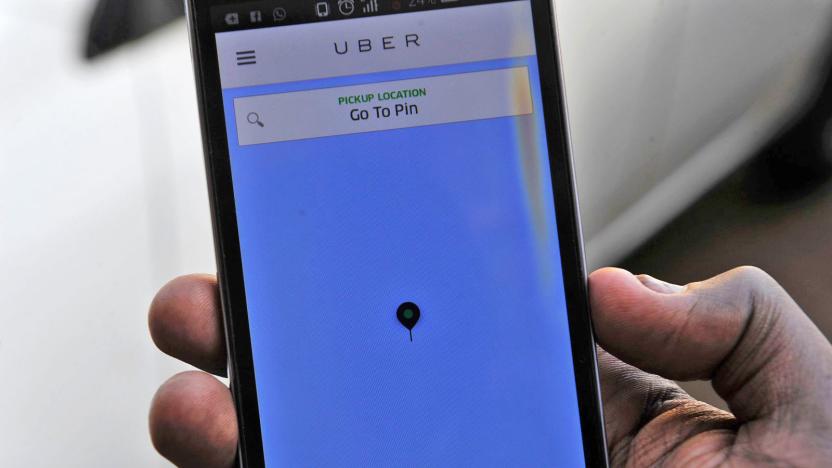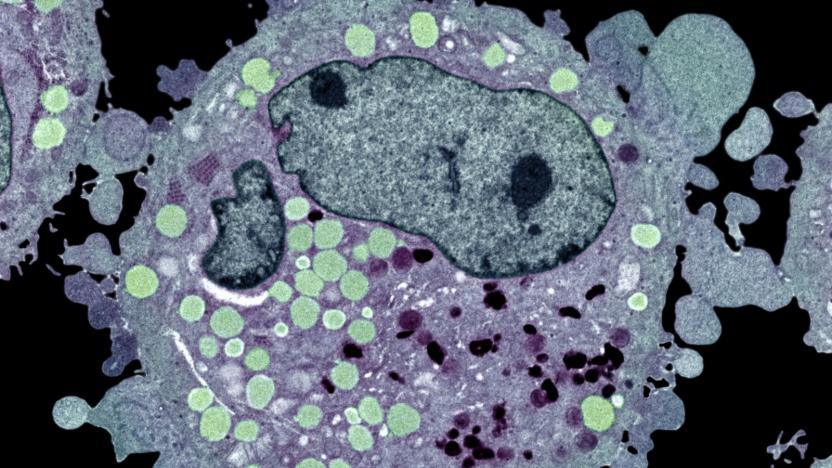stanford
Latest

ICYMI: The balloon bot that can actually stand upright
try{document.getElementById("aol-cms-player-1").style.display="none";}catch(e){}Today on In Case You Missed It: A scientist at UCLA's Robotics & Mechanisms Laboratory is experimenting with a way to get around the fact that robots have a difficult time maintaining a high center of gravity, aka they always fall down; so he's built something that looks like a balloon on stick insect legs. It's still very much a prototype but perhaps the idea will remain in future walking bots. Meanwhile, scientists at SLAC came up with a way to spot photosynthesis at room temperature, using an X-ray laser. Previous tests had always relied on freezing leaves to track it. If you're getting your projects in order for the coming weekend, we recommend the DIY fire tornado. If you're looking for the Rubix Cube solving bot, that's here. As always, please share any interesting tech or science videos you find by using the #ICYMI hashtag on Twitter for @mskerryd.

Study: most students can't spot fake news
If you thought fake online news was a problem for impressionable adults, it's even worse for the younger crowd. A Stanford study of 7,804 middle school, high school and college students has found that most of them couldn't identify fake news on their own. Their susceptibility varied with age, but even a large number of the older students fell prey to bogus reports. Over two thirds of middle school kids didn't see why they shouldn't trust a bank executive's post claiming that young adults need financial help, while nearly 40 percent of high schoolers didn't question the link between an unsourced photo and the claims attached to it.

X-ray laser spots photosynthesis in real-life conditions
Humanity has known about the life-giving photosynthesis process for a long time, but studying it in real-world conditions has often been impractical. You've typically had to freeze samples to get a good look, which isn't exactly natural. However, the SLAC National Accelerator Laboratory just managed a breakthrough: it used its x-ray laser to capture detailed snapshots of photosynthesis at room temperature. The trick was to place protein complex samples in a solution, put that on a conveyor belt, light it up with a green laser (to start the water-splitting reaction) and capture images using x-ray pulses. As those pulses are extremely fast -- just 40 femtoseconds long -- you can collect crystallization and spectroscopy data before the sample meets its untimely end.

ICYMI: Augment yourself with video glasses and exosuits
Today on In Case You Missed It: Between Snap Inc.'s more-buzz-than-Google-Glass sunglasses and exoskeleton suits for the workplace, we are officially future-living. Spectacles cost $130 and are dispensing in randomly placed vending machines. Meanwhile, SuitX, a robotics company from California, created three exosuit options designed to help physical laborers do their jobs and stay injury-free. Stanford researchers have a system that uses chemicals rather than electrons to send text messages, and Texas A&M's gymnastics team created an amazing mannequin challenge that must be seen to be believed. As always, please share any interesting tech or science videos you find by using the #ICYMI hashtag on Twitter for @mskerryd.

Stanford develops CRISPR-based therapy for sickle cell disease
A team of Stanford scientists are making great progress in their search for a cure for sickle cell disease, and they want to start human trials as soon as 2018. They used CRISPR to fix the mutated gene that causes the illness in human stem cells taken from actual patients. The CRISPR technique gave them a way to carve out the faulty part of the gene and replace it with the normal DNA sequence that was supposed to be there in the first place. That prevents previously affected red blood cells from transforming into tiny sickles that have the tendency to clog blood vessels and cause organ damage.

Uber and Lyft aren't immune to racial discrimination by drivers
For a while, ridesharing has been seen as a possible solution to the racial discrimination you sometimes see with taxis. If drivers can't always see or hear you first, they're less likely to reject your request, right? Unfortunately, the industry isn't entirely color-blind. A newly published study reveals that there's still some bias in the ridesharing world. Uber drivers in Boston were over twice as likely to cancel rides on people with black-sounding names, for example, while black men waiting for rides in Seattle faced tangibly longer wait times for both Lyft and Uber.

ICYMI: Wearable robots will walk all over you
try{document.getElementById("aol-cms-player-1").style.display="none";}catch(e){} Today on In Case You Missed It: MIT and Stanford researchers created tiny robots that can grab onto clothes and walk on your shirt, with the goal of them one day, forming a swarm to create a temporary video screen and then marching back into a pocket, putting themselves away. Meanwhile Japanese scientists were able to create mice offspring from skin cells of adult mice. They're testing the method next with primates, so this is going to get even weirder. In TL;DR, we're rounding up some of the biggest headlines from the week and we think it's particularly interesting to note how much money technology companies now spend on lobbying in Washington, D.C. (And share it with your friend who still thinks tech and politics aren't related.) Also if you need to send that smoking Samsung video to someone stat, the original video is here. As always, please share any interesting tech or science videos you find by using the #ICYMI hashtag on Twitter for @mskerryd.

Tiny body-roaming robots could be the future of wearables
Wearables have gotten smaller and less obtrusive over the years, culminating in today's compact fitness trackers and smartwatches that stay immobile and out of the way. But that doesn't have to be the case. Researchers at MIT and Stanford teamed up to develop Rovables, miniature robots chock full of sensors that roam around the human body while the wearer goes about their lives.

ICYMI: Airbag helmets might save your noggin
try{document.getElementById("aol-cms-player-1").style.display="none";}catch(e){}Today on In Case You Missed It: Stanford researchers just wrapped up a study of bike helmets that found a clear winner with the caveat that it's not available in the US yet. Airbag helmets (like these) are only sold in Europe but are far superior at keeping test heads safe in an impact.

Fluctuating brain networks help you handle complex tasks
Researchers already know that the human brain isn't static, but it's now clear just how dynamic the mind can be. A Stanford University team has discovered that the networking between brain regions will fluctuate depending on the complexity of tasks. If you're at rest, your brain's components are relatively isolated. Handle a complicated activity, however, and the level of networking ramps up. The more interconnected your brain is, the better your performance -- in a memory test, those with the most integrated brains were the quickest and most accurate.

23andMe helps identify genetic links to common skin cancer
The team at 23andMe is clearly going out of its way to show that huge amounts of volunteered genetic data can boost medical research. Scientists at both 23andMe and Stanford used data from consenting customers to conduct the largest ever genetic study of basal cell carcinoma, the most typical form of skin cancer, and made numerous discoveries. They found 14 previously unidentified genetic associations with the cancer, some of which might pinpoint when you're at increased risk. Some gene regions linked to basal cell carcinoma have a larger effect on the young, hinting that environmental factors might play a greater role in getting the cancer as you age. Also, a gene marker's interactions suggest that your risk goes up when you have black or brown hair, and gene areas that maintain telomeres (chromosome ends) played their own part.

Postage stamp-sized device can disinfect water in minutes
In many parts of the world, people have to boil water or leave it for long periods under the sun to make sure it's clean enough to drink. Problem is, the former consumes fuel they can use for cooking or heating, while the latter takes too much time. A tiny device that's developed by Stanford University and SLAC National Laboratory could change that. While it's only half the size of a postage stamp, it can harness the the power of the sun to kill 99.99 percent of germs in as fast as 20 minutes. You simply have to drop it into the container of water you want to cleanse and leave it outside for a bit.

Google will power Stanford's genomics service
Stanford aims to make genetic testing a normal part of patient care, and it's teaming up with Google to make that happen. The university's School of Medicine will launch Clinical Genomics Service this fall, which is powered by Google Genomics that stores DNA data in the cloud. DNA sequencing is built into the system -- doctors that request for it will get a large amount of data back. They can then use Google Cloud to analyze the data they get and compare it against other information in the system to find any anomaly that might be responsible for a patient's condition. It could improve how doctors treat different cancers and help decipher illnesses that are especially hard to diagnose and treat correctly.

ICYMI: Reinvented wheel and drones that can evade
try{document.getElementById("aol-cms-player-1").style.display="none";}catch(e){}Today on In Case You Missed It: Stanford is teaching drones how to avoid either existing obstacles or ones that come in the form of an attacking human. It all works in real-time, which is why the video of the technology in action shows a fencer sparring with the drone. German students have created a wheel that works like a robotic bicycle chain, morphing its shape from round to triangular -- whatever is needed to get over obstacles in its path. Please watch the video from YouTuber Useless Duck Company for a Nintendo laugh. As always, please share any interesting tech or science videos you find by using the #ICYMI hashtag on Twitter for @mskerryd.

ICYMI: Pedestrian tracking bot and earthquake simulation
try{document.getElementById("aol-cms-player-1").style.display="none";}catch(e){}Today on In Case You Missed It: Stanford engineers are using a robot to understand the way humans move through a crowded space. University of California, San Diego researchers are using the world's largest outdoor shake table to simulate earthquakes and fire to a six story building. If you can get into topics unrelated to Dallas and police shootings this weekend, German churches are using wifi to try to lure new attendees. As always, please share any interesting tech or science videos you find by using the #ICYMI hashtag on Twitter for @mskerryd.

Gene editing can end disease and fight global famine
We're looking at the single greatest advancement in genetics since Mendelev started growing peas. CRISPR-Cas9 gene-modification technology is powerful enough to cure humanity's worst diseases, yet simple enough to be used by amateur biologists. You thought 3-D printers and the maker movement were going to change the world? Get ready for a new kind of tinkerer -- one that wields gene-snipping scissors.

Big data shows racial bias in police behavior
Stanford University just delivered further proof that massive, readily available data sets can solve tricky law enforcement problems. School researchers combing through a mix of 28,119 Oakland Police Department stop reports, officer body camera footage and community surveys have learned that there are "significant" racial biases at play. OPD officers are not only more likely to stop a black person, but far more likely to conduct searches of black people, even though they weren't any more likely to find something incriminating. Officers more frequently handcuffed black people without arresting them, too. And the pattern is the same regardless of the crime rate in a given region.

Stanford looks to the skies to calculate underground water
A team at Stanford has pioneered a new use of satellite imagery that could help its home state avoid future water supply issues. Previous Stanford research had already proved satellite images (specifically Interferometric Synthetic Aperture Radar) of minute changes in ground elevation could provide reliable clues to underground water flow. The problem was, only tiny sections of the images provide useful data, and analyzing them is a laborious, manual process. Hopefully not for long.

ICYMI: Sea drones, pigeon pollution patrol and more
#fivemin-widget-blogsmith-image-599630{display:none;} .cke_show_borders #fivemin-widget-blogsmith-image-599630, #postcontentcontainer #fivemin-widget-blogsmith-image-599630{width:570px;display:block;} try{document.getElementById("fivemin-widget-blogsmith-image-599630").style.display="none";}catch(e){} Today on In Case You Missed It: A more affordable ocean-going drone is about to hit the market for about $3,000. We doubt it can reach the amazing things continually being sighted along the Mariana Trench, but it's fun to dream. People at the Science Museum in London are trying to rebuild the first British robot. And this happened a month ago but we just discovered it and can't stop talking about it: Pigeons in London were sent on test flights to collect pollution stats in their tiny air quality smart vests. Please take in the splendor of this image and share with every animal freak you know. If you're into art, you might appreciate these modern pop-up books. As always, please share any great tech or science videos you find by using the #ICYMI hashtag on Twitter for @mskerryd.

ICYMI: 3D-printed instrument, Humanoid diver and more
#fivemin-widget-blogsmith-image-99267{display:none;} .cke_show_borders #fivemin-widget-blogsmith-image-99267, #postcontentcontainer #fivemin-widget-blogsmith-image-99267{width:570px;display:block;} try{document.getElementById("fivemin-widget-blogsmith-image-99267").style.display="none";}catch(e){}Today on In Case You Missed It: Free 3D plans to create your own plastic violin should make the instrument a bit easier to take up; Stanford roboticists created a remotely-operated humanoid diver that can be haptically controlled from afar by its pilots, meaning they can feel what the diver does. And a table tennis projector can coach you on improving your lousy game, so nothing like this ever happens to you. Sick of those updates popping up during important moments? It can't be as bad as being live on-air. As always, please share any great tech or science videos you find by using the #ICYMI hashtag on Twitter for @mskerryd.





